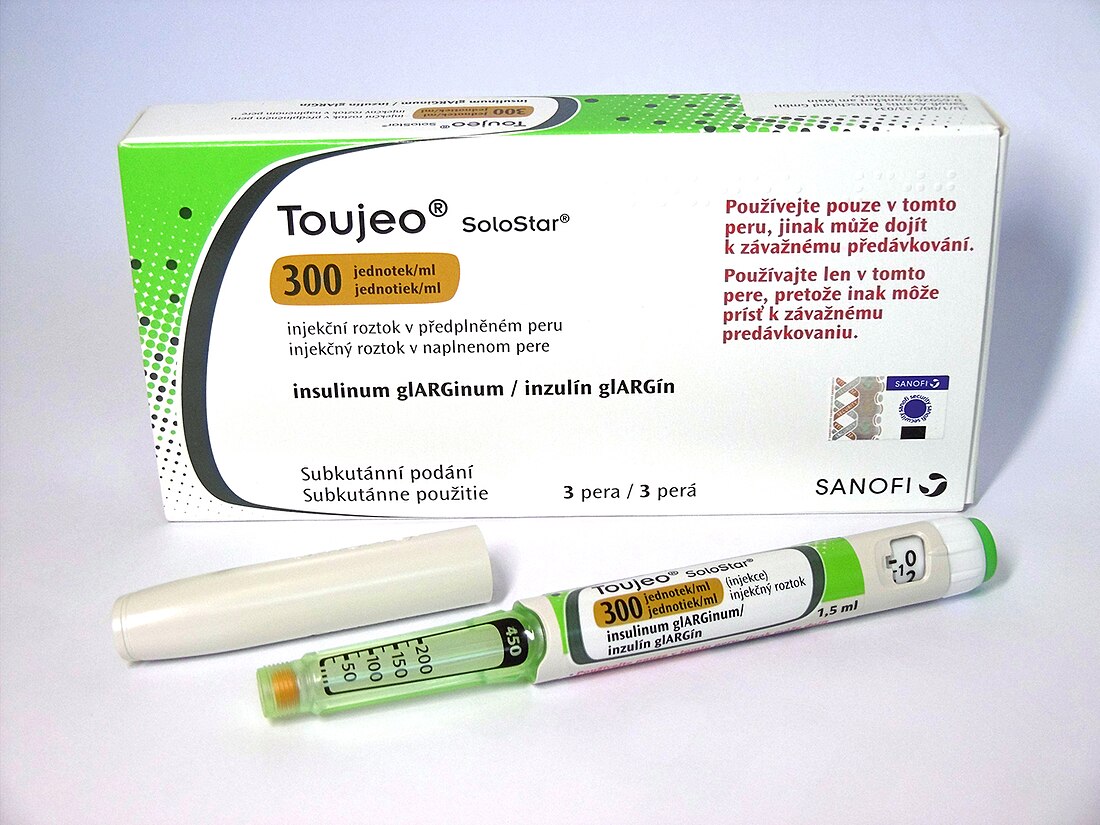Top Qs
Timeline
Chat
Perspective
Insulin glargine
Long-acting insulin From Wikipedia, the free encyclopedia
Remove ads
Insulin glargine sold, among others, under the brand name Lantus (manufactured and marketed by Sanofi) is a long-acting modified form of medical insulin, used in the management of type 1 and type 2 diabetes.[7] It is injected just under the skin.[7] Effects generally begin an hour after use.[7]
Common side effects include low blood sugar, problems at the site of injection, itchiness, and weight gain.[7] Other serious side effects include low blood potassium.[7] NPH insulin rather than insulin glargine is generally preferred in pregnancy.[8] After injection, microcrystals slowly release insulin for about 24 hours.[7] This insulin causes body tissues to absorb glucose from the blood and decreases glucose production by the liver.[7]
Insulin glargine was patented, but the patent expired in most jurisdictions in 2014. It was approved for medical use in the United States in 2000.[7] It is on the World Health Organization's List of Essential Medicines.[9] In 2023, it was the 30th most commonly prescribed medication in the United States, with more than 18 million prescriptions.[10][11] In July 2021, the US Food and Drug Administration (FDA) approved an interchangeable biosimilar insulin product called Semglee (insulin glargine-yfgn) for the treatment of diabetes.[12]
Remove ads
Medical uses
Summarize
Perspective
Parts of this article (those related to documentation) need to be updated. (January 2022) |
The long-acting insulin class, which includes insulin glargine, do not appear much better than neutral protamine Hagedorn (NPH) insulin,[13] but do have a greater cost, making them, as of 2010, not cost effective for the treatment of type 2 diabetes.[14] In a previous review it was unclear if there is a difference in hypoglycemia, as there was not enough data to determine any differences with respect to long term outcomes,[15] however a more recent Cochrane systematic review did not find clinically significant difference when comparing insulin glargine to NPH insulin, insulin detemir or insulin degludec in the management of type 1 diabetes in either adults or children over periods of 6 months or longer.[13] It is not typically the recommended long-acting insulin in the United Kingdom.[8]
Semglee is indicated to improve glycemic control in adults and children with type 1 diabetes and in adults with type 2 diabetes.[12] Semglee is both biosimilar to, and interchangeable with its reference product Lantus (insulin glargine), a long-acting insulin analog.[12]
Mixing with other insulins
The American Diabetes Association said in 2003 that, unlike some other longer-acting insulins, glargine should not be diluted or mixed with other insulin or solution in the same syringe, due to the low pH of its diluent.[16] However, a 2004 study found that mixing glargine with other insulins did not affect short-term glycemic profile.[17]
Remove ads
Adverse effects
Common side effects include low blood sugar, problems at the site of injection, itchiness, and weight gain.[7] Serious side effects include low blood potassium.[7]
As of 2012, tentative evidence shows no association between insulin glargine and cancer.[18] Previous studies had raised concerns.[19]
When comparing insulin glargine to NPH insulin, insulin detemir or insulin degludec, no significant adverse effects were found in the management of type 1 diabetes in either adults or children in periods of six months or longer.[13]
Remove ads
Pharmacology
Mechanism of action
Insulin glargine differs from human insulin by replacing asparagine with glycine in position 21 of the A-chain and by carboxy-terminal extension of B-chain by 2 arginine residues. The arginine amino acids shift the isoelectric point from a pH of 5.4 to 6.7, making the molecule more soluble at an acidic pH and less soluble at physiological pH. The isoelectric shift also allows for the subcutaneous injection of a clear solution. The glycine substitution prevents deamidation of the acid-sensitive asparagine at acidic pH. In the neutral subcutaneous space, higher-order aggregates form, resulting in a slow, peakless dissolution and absorption of insulin from the site of injection.[20]
History
In June 2000, the European Commission formally approved the launching of Lantus by Sanofi-Aventis Germany in the European Union.[21] The admission was prolonged on 9 June 2005.[22]
A three-fold more concentrated formulation, brand name Toujeo, was introduced after FDA approval in 2015.[23][24]
Legal status
Summarize
Perspective
Biosimilars
As of 2025, there are two commercially available insulin glargine biosimilars in the USA:
- Semglee (glargine-yfgn) received FDA approval in July 2021. The approval was granted to Mylan, which had merged with Upjohn into Viatris in 2020.
- Rezvoglar (glargine-aglr) was approved by the FDA in December 2021 to be produced by Lilly.
Europe was much earlier with approving Insulin glargine biosimilars:
- Abasaglar (Eli Lilly and Boehringer Ingelheim) was approved for medical use in the European Union in September 2014.[25][26]
- Lusduna (Merck Sharp & Dohme (MSD), which is the name under which Merck operates outside of the U.S. and Canada) was approved for medical use in the European Union in January 2017.[27]
- Semglee (Mylan and Biocon Biologics) was approved for medical use in the European Union in March 2018.[28]
Patent expiry
Patent protection for insulin glargine expired in Europe and the US in 2014.[29] Insulin glargine from competitor Eli Lilly became available in most countries during 2015, under the brand names Basaglar (as a follow-on in the US) and Abasaglar (as a biosimilar in the EU).[29]
Brand names
Insulin glargine is available under brand names including Basaglar, Lantus, and Toujeo.
Remove ads
References
Wikiwand - on
Seamless Wikipedia browsing. On steroids.
Remove ads

